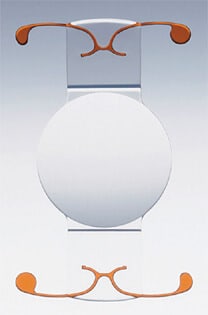
The first intraocular device designed to provide a full range of vision- distance, intermediate, and near- after cataract surgery was approved by the FDA and has been available for clinical use for now over a decade, longer than any other premium intraocular lens. The “CrystaLens™” incorporates a unique concept in design. It is soft and flexible and is able to change focus. As a patient looks at distant, intermediate or near objects, the lens changes its power. In this way this new intraocular lens is able to restore a more youthful and natural range of vision to patients over 55 years of age. No other device available today is able to provide this range of visual function.
The CrystaLens Accomodating Intraocular Lens is a foldable lens made from a proprietary solid silicone, Biosil™. The lens has modified plate haptics with a biconvex optic. The lens is hinged adjacent to the opric and has small looped polymie haptics. Overall length: 11.5 mm; biconvex optic is 4.5 mm in diameter. The picture shows side view. The Crystalens is now also available in an astigmatism correcting version: the Trulign™. This newest version expands the possibilities for vision correction during cataract surgery as the only lens that allows a range of vision while also correcting astigmatism.
Crystalens is a revolutionary new breakthrough in vision enhancement by Bausch and Lomb. It is the first and only intraocular lens (IOL) replacement for cataracts that focuses like the eye’s natural lens, allowing for continuous vision up close, far away and all distances in between. By using the eye’s muscle to move the lens backwards and forwards naturally in response to the brain’s desire to see at different distances, Crystalens enables the eye to focus continuously and seamlessly through a range of distances, including near, far and everything in between. Patients experience the vision that is most like the vision they had when they were younger. It does not guarantee that you will not need glasses for near vision, but it reduces the dependence on glasses significantly. There are even some patients who receive the technology that will not need to use reading glasses, but each patient is unique.
Dr. Colvard, an experienced Crystalens surgeon, shares his knowledge of the lens, through this article, to help other surgeons flatten the learning curve: “Moving Forward With the Crystalens.”
Dr. Kandavel was one of the first doctors to implant the lens in California, and both doctors were pioneers in the field, participating in the FDA trials that led to the approval of the Crystalens and Trulign IOL. This makes them two of the the most experienced Crystalens surgeons in the United Sates.
Crystalens is very different from other lens implants especially intraocular lenses. The Crystalens implant allows your eye and it’s natural muscles to focus on objects at various distances. Intraocular lenses do not. They only allow you to focus on objects at a certain distance and you may be required to wear glasses for near or middle vision. It’s important to note that not everyone will gain 20/20 vision at all distances after this procedure. It is also important to point out that even after having this procedure done and having the possibility of having 20/20 vision, you still may not increase your chances to read or focus on objects in low light. As we get older, we lose our ability to focus on objects under these conditions. Our health and health of our eyes will also determine this outcome regardless of any type of refractive surgery.
The implant procedure is a safe and proven cataract procedure performed in an outpatient surgical facility. The procedure itself lasts about 20 minutes or less and is pain free. A few drops are put into your eye by the surgeon and an ultrasonic probe is used to remove the cloudy lens from the eye. The Crystalens implant is then put in place of the original lens used to be. When this procedure is complete, the doctor will put additional drops in your eye to prevent infection and help with any inflammation that may occur. The opening of the eye is very small and allows for quick healing. No stitches are required. Most people have 20/20 vision after the procedure but not everyone.
The Crystalens procedure is normally performed in one dominant eye to determine the outcome of your vision in both eyes. Of course both eyes usually develop cataracts, so in this case of 2 eyes having bad vision, the surgeon will prefer to wait 2 to 3 weeks before inserting a second implant, or implant in the second eye. For more information regarding this issue, it’s best to consult with your surgeon.
The Crystalens is ideally suited for men and women aged 50 to 64 years of age with cataracts who want to not only restore clarity in their vision but restore their near, intermediate and distance vision. Almost anyone who has cataracts are candidates for the Crystalens procedure so long as you are healthy and do not have any serious eye diseases or disorders like uncontrolled diabetes. You may also be a candidate even if you have had previous refractive surgery. The best way to find out if you are a candidate for this procedure is to visit your local eye doctor for an exam. If you have already had cataract surgery, you are not a candidate for this procedure. To view a list of frequently asked questions, and for more information about Crystalens visit www.bausch.com/en/our-products/surgical-products/cataract-surgery/crystalens-ao.
Colvard-Kandavel Eye Center offers personalized eye care services for patients with routine and complex eye conditions.
Our team is here to help you make an appointment with the specialists that you need.